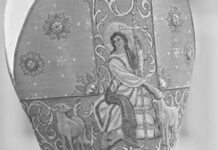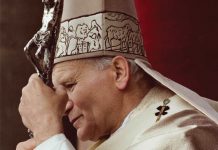Saint Stanislaus Kostka – who died in 1568 just a few months shy of his eighteenth birthday – is one of the most popular saints in Poland. His short life demonstrates two primary lessons: That much can be done in little time, and that whatever time we are given here on earth, it’s all given us to get to heaven.
Stanislaus realized this from his earliest years, whether by natural intuition, or by the grace of God, or, most likely, both. He was from noble lineage, his family wealthy, and the last thing they wanted was for their boy to join the newly-founded radical Jesuits, which to their mind was throwing it all away.
But that’s just what he did. One morning, the young lad dressed himself as a mendicant to escape detection, and set out on the 400-mile (!) trek to Augsburg, where fellow saint Peter Canisius was the provincial, to seek permission to enter the Jesuit novitiate.
When they realized Stanislaus had gone missing, his older brother Paul and his tutor took off in haste to catch up, but they were not able to do so, by a series of mysterious, and perhaps miraculous, setbacks. Stanislaus arrived at his destination – also quasi-miraculous – was accepted after a brief postulancy, and eventually made his way to Rome to begin his novitiate.
He was, by all accounts, a model religious, not only keeping the rule, but going above and beyond, always cheerful and jovial, yet serious about serious things. He was sickly, experiencing severe chest pains, but would not spare himself. His devotion to the Blessed Virgin was exemplary, and she granted him many favours, including the final one, which was to receive Stanislaus into heaven on the morning of her primary feast, the Assumption, after the young novice had fallen into his final fever on the eve of the feast of Saint Lawrence, August 10th, 1568. Stanislaus had predicted this, in full hope and assurance – and when he died five days later, on the Solemnity of the Assumption, he was by popular acclaim declared a saint – subito santo! Sure enough, rare in those days, he was soon beatified by Pope Paul V on October 8th, 1605, and canonized by Pope Benedict XIII on December 31st, 1726.
Devotion to Saint Stanislaus continues throughout the world, and especially in his native Poland, which could certainly use his intercession, especially for the young, so many of whom are abandoning the Faith which has held their nation together through her bitter trials.
We were not made for this world, but for heaven, summed up in Stanislaus’ own motto, ad maiora natus sum – I was born for greater things. Just so, and a message our world immersed in a blind and deadly secularism desperately needs to hear.
Saint Stanislaus Kostka, Módl się za nami!
In the United States, November 13th is the memorial of Saint Frances Xavier Cabrini, or ‘Mother Cabrini’ (1850 – 1917) as she came to be known. From her earliest years, she was drawn to religious and missionary life. Although of frail health, or perhaps because of such, as God works best through our weakness, she accomplished far more than one may have expected from her limited human frame. As she was later to put it:
I travel, work, suffer my weak health, meet with a thousand difficulties, but all these are nothing, for this world is so small. To me, space is an imperceptible object, as I am accustomed to dwell in eternity.
The first part of her apostolic life was spent in her native Italy, until, at the request of Pope Leo XIII, she traveled to the United States when just shy of her fortieth birthday, and went on to become the first naturalized citizen of America to be canonized. She and her companions in the Order she founded – the Missionary Sisters of the Sacred Heart of Jesus – worked with immigrants, especially Italians, mothers, the poor, in education, orphanages, health care, whatever really was needed in the maelstrom of the emergent melting pot of America.
At her death, she had founded 67 houses across America, Europe and South America, and her Order continues to thrive. She was canonized on July 7th, 1946 by Pope Pius XII, and is held in great veneration as a spiritual mother to all. This immense work was all the fruit of her deep, interior communion with God:
They who pray with faith have fervour and fervour is the fire of prayer. This mysterious fire has the power of consuming all our faults and imperfections, and of giving to our actions, vitality, beauty and merit.
A final note: In a movement in New York city a few years go to honour women who helped ‘build the city’, the same city which first welcomed Sister Frances and millions of other immigrants, Mother Cabrini received the most votes in a poll of regular New Yorkers, a grand and good sign. Sadly, the will of the people – the sensus fidelium, if you will – was quashed by a panel, including the then-mayor’s wife, Chirlane McCray. It seems their proclivities were to choose instead to a jazz musician and a drag queen, signifying the interesting priorities of the ‘elite’, and the cultural trend of the republic. Now, the Big Apple has a Muslim mayor. Such are the vagaries of this passing life.
Ah, well, amare nesciri, as Saint Philip exhorted, ‘love to be unknown’. So long as God knows, and His truth will soon be shouted from the rooftops.
Saint Francis Xavier Cabrini, ora pro nobis! +











